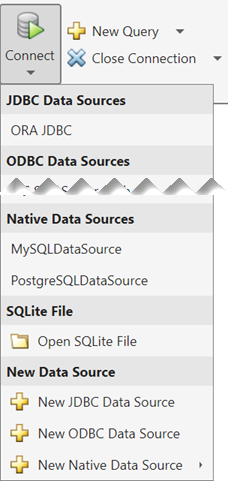Interact with Data in SQLite Database Using MATLAB Interface to SQLite
To analyze your data using SQL in MATLAB® without access to any database or driver, use the MATLAB interface to SQLite. After installing Database Toolbox™, you can use the MATLAB interface to SQLite to move data between MATLAB and an SQLite database file. For details, see MATLAB Interface to SQLite. The SQLite connection is different from a database connection created using a JDBC driver. For background information about SQLite databases, see the SQLite Home Page.
MATLAB Interface to SQLite Advantages
With the MATLAB interface to SQLite, you can start working with data immediately after installing the Database Toolbox by creating an SQLite database file. No installation or administration of software or drivers is required. You can share data using SQLite database files. Also, you can deploy a standalone database application without additional installation or configuration on target machines. The MATLAB interface to SQLite supports Windows®, Linux®, and Mac.
Command Line Workflow for MATLAB Interface to SQLite
To connect to a database quickly and import data, use the MATLAB interface to SQLite. These steps provide a high-level workflow for using the MATLAB interface to SQLite.
Create an SQLite database file by using
sqlite. The SQLite database file has a.dbextension. Thesqliteobject signifies an SQLite database connection.Create tables in the SQLite database file by using
execute.Export your data into the SQLite database file by using
sqlwrite.Perform data analysis in MATLAB.
Export results into the SQLite database file by using
sqlwrite.Close the SQLite connection by using
close.Share the SQLite database file with others.
Create a standalone SQLite database application and deploy it.
Database Explorer App Workflow for MATLAB Interface to SQLite
If you have an existing SQLite database file, you can use the Database Explorer app to create an SQLite connection. These steps show how to create the connection.
Open the Database Explorer app.
In the Connections section, click Connect.
Select Open SQLite File.

Navigate to the folder where your SQLite database file exists and select the file. Click OK.
Database Explorer creates an SQLite connection. The Database Browser pane displays the available tables in the database.
After you create the SQLite connection, you can use Database Explorer to explore the data in the SQLite database and import the data into MATLAB. For details, see these topics:
SQLite JDBC Connection Differences
The following table describes the differences between using the MATLAB interface to SQLite and using the JDBC driver to connect to an SQLite database.
Item | SQLite Connection Using the MATLAB Interface to SQLite | SQLite Database Connection Using a JDBC Driver |
|---|---|---|
Driver installation | Not required | Required |
Database installation | Not required | Required |
Database administration | Not required | Required |
Database connection function | sqlite | database |
Import data | Yes | Yes |
Export data | Yes | Yes |
Database operations | Yes | Yes |
Database Explorer | Yes | Yes |
Database metadata | No | Yes |
Complex functionality | No | Yes |
MATLAB Interface to SQLite Limitations
The limitations of using the MATLAB interface to SQLite are:
NULLvalues are not supported as the first value in any column.Database import options are not supported.
See Also
Topics
- Access Relational Database Data in MATLAB
- Import Data Using MATLAB Interface to SQLite
- Insert Data into SQLite Database Table
- Create Table and Add Column in SQLite Database
- Deploy MATLAB Interface to SQLite Database Application with MATLAB Compiler